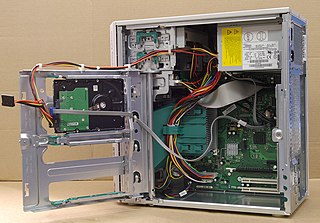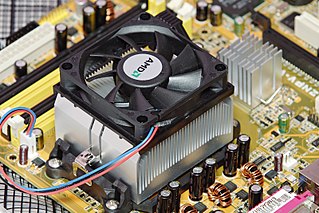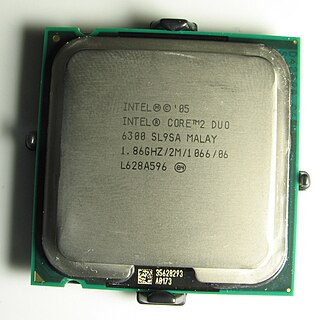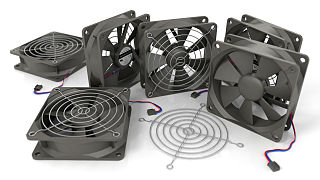Airflow pattern
As with most computers, the rear fan and power supply fan exhaust, moving hot air away from the computer. This causes a slight depressurization inside the chassis, and requires all other openings to become intake vents. Airflow from the front of the chassis moves around the Chassis Air Guide, allowing the processor fan to only draw air from outside the chassis, providing more effective cooling.
System fans
The rear chassis exhaust fan is required to be at least 92-mm or larger, providing a minimum of 55 CFM in free air. The processor is required to have an active cooling system, consisting of a fan and heat sink.
Side-panel venting
The side-panel is required to have an add-in card vent, which provides room temperature air to the add-in cards. High-performance graphics cards will benefit from the lower temperature air.

The Pentium III brand refers to Intel's 32-bit x86 desktop and mobile microprocessors based on the sixth-generation P6 microarchitecture introduced on February 26, 1999. The brand's initial processors were very similar to the earlier Pentium II-branded microprocessors. The most notable differences were the addition of the SSE instruction set, and the introduction of a controversial serial number embedded in the chip during the manufacturing process.

Overclocking in the context of computing devices refers to making them "run faster" than originally intended. More specifically it is the configuration of computer hardware components to operate faster than certified by the original manufacturer, with "faster" specified as clock frequency in megahertz (MHz) or gigahertz (GHz). Commonly operating voltage is also increased to maintain a component's operational stability at accelerated speeds. Semiconductor devices operated at higher frequencies and voltages increase power consumption and heat. An overclocked device may be unreliable or fail completely if the additional heat load is not removed or power delivery components cannot meet increased power demands. Many device warranties state that overclocking and/or over-specification voids any warranty.
A quiet PC is a personal computer that makes very little, or no noise. Common uses for quiet PCs include video editing, sound mixing and home theater PCs, but noise reduction techniques can also be used to greatly reduce the noise from servers. There is currently no standard definition for a "quiet PC", and the term is generally not used in a business context, but by individuals and the businesses catering to them.

Socket 370 is a CPU socket first used by Intel for Pentium III and Celeron processors to first complement and later replace the older Slot 1 CPU interface on personal computers. The "370" refers to the number of pin holes in the socket for CPU pins.

A northbridge or host bridge is one of the two chips in the core logic chipset architecture on a PC motherboard, the other being the southbridge. Unlike the southbridge, northbridge is connected directly to the CPU via the front-side bus (FSB) and is thus responsible for tasks that require the highest performance. The northbridge is usually paired with a southbridge, also known as I/O controller hub. In systems where they are included, these two chips manage communications between the CPU and other parts of the motherboard, and constitute the core logic chipset of the PC motherboard.

BTX is a form factor for motherboards, originally intended to be the replacement for the aging ATX motherboard form factor in late 2004 and early 2005.

Computer cooling is required to remove the waste heat produced by computer components, to keep components within permissible operating temperature limits. Components that are susceptible to temporary malfunction or permanent failure if overheated include integrated circuits such as central processing units (CPUs), chipset, graphics cards, and hard disk drives.

LGA 775, also known as Socket T, is an Intel desktop CPU socket. LGA stands for land grid array. Unlike earlier common CPU sockets, such as its predecessor Socket 478, the LGA 775 has no socket holes; instead, it has 775 protruding pins which touch contact points on the underside of the processor (CPU).

A computer case, also known as a computer chassis, tower, system unit, CPU, or cabinet, is the enclosure that contains most of the components of a computer.
A wax motor is a linear actuator device that converts thermal energy into mechanical energy by exploiting the phase-change behaviour of waxes. During melting, wax typically expands in volume by 5% to 20%.

All electronic devices and circuitry generate excess heat and thus require thermal management to improve reliability and prevent premature failure. The amount of heat output is equal to the power input, if there are no other energy interactions. There are several techniques for cooling including various styles of heat sinks, thermoelectric coolers, forced air systems and fans, heat pipes, and others. In cases of extreme low environmental temperatures, it may actually be necessary to heat the electronic components to achieve satisfactory operation.
TM2, or Thermal Monitoring 2, is a throttling control method used on LGA 775 versions of the Pentium 4, Pentium D and Celeron processors and also on the Pentium M series of processors. TM2 reduces processor temperature by lowering the CPU clock multiplier, and thereby the processor core speed.
Passive cooling is a building design approach that focuses on heat gain control and heat dissipation in a building in order to improve the indoor thermal comfort with low or no energy consumption. This approach works either by preventing heat from entering the interior or by removing heat from the building. Natural cooling utilizes on-site energy, available from the natural environment, combined with the architectural design of building components, rather than mechanical systems to dissipate heat. Therefore, natural cooling depends not only on the architectural design of the building but on how the site's natural resources are used as heat sinks. Examples of on-site heat sinks are the upper atmosphere, the outdoor air (wind), and the earth/soil.

Conroe is the code name for many Intel processors sold as Core 2 Duo, Xeon, Pentium Dual-Core and Celeron. It was the first desktop processor to be based on the Core microarchitecture, replacing the NetBurst microarchitecture based Cedar Mill processor. It has product code 80557, which is shared with Allendale and Conroe-L that are very similar but have a smaller L2 cache. Conroe-L has only one processor core and a new CPUID model. The mobile version of Conroe is Merom, the dual-socket server version is Woodcrest, and the quad-core desktop version is Kentsfield.
Conroe was replaced by the 45 nm Wolfdale processor.
An operating temperature is the temperature at which an electrical or mechanical device operates. The device will operate effectively within a specified temperature range which varies based on the device function and application context, and ranges from the minimum operating temperature to the maximum operating temperature. Outside this range of safe operating temperatures the device may fail. Aerospace and military-grade devices generally operate over a broader temperature range than industrial devices; commercial-grade devices generally have the narrowest operating temperature range.
The Dell Inspiron series of laptop computers was introduced in 2000 as a consumer oriented line, available to the general public through electronics and department stores, contrasting to the business/enterprise-oriented Dell Latitude series of laptop computers, and are usually ordered from Dell directly via the website, phone, or mail-order.











